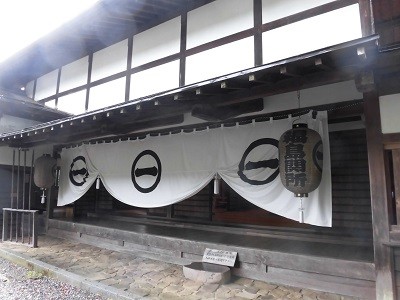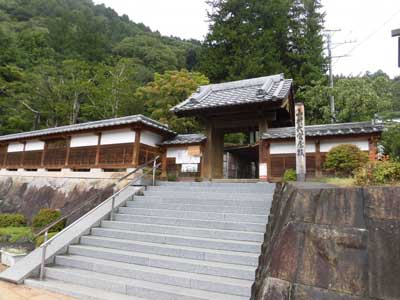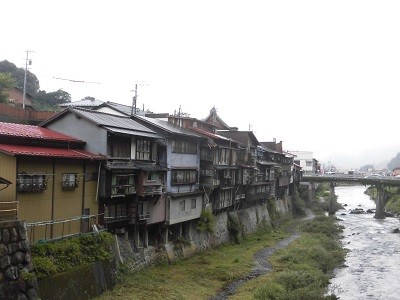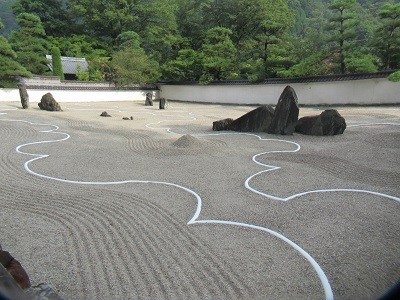Kiso-Fukushima is a small town in Nagano Prefecture on the Nakasendo Trail. The Nakasendo is an old trail connecting Edo (former name of Tokyo) and Kyoto. The Tokugawa Shogunate built it in the early 17th century. There were 69 post towns on the trail. Kiso-Fukushima was one of these post towns. It was the biggest one in the Kiso area, which includes other famous post towns like Tsumago and Magome. The population of the town in 1843 was about 1,000 while Tsumago had about 400 people.
History of Kiso-Fukushima
After Tokugawa Ieyasu won the Battle of Sekigahara was won in 1600, he created his military government in Edo (Tokyo). He constructed 5 main routes connecting Edo and other major regions in Japan. He made two routes between Edo and Kyoto, the Tokaido and Nakasendo.
The Tokaido trail on the Pacific Ocean side was shorter, but a part of the route was often closed. This happened because of flooding, and while the Nakasendo is longer, it is less likely to be closed due to weather circumstances. Kiso-Fukushima was the 37th post town out of 69. In 1623, a checkpoint was placed in the town to check the passers-by.
Sekisho, Former Checkpoint
This checkpoint is in the northern part of the town. Local officials checked mostly weapons and ladies. Wives and first sons of feudal lords had to live in Edo as hostages by the order of the Shogun. So if the wives tried to escape from Edo, it was regarded as a sign of attack.

Access: 20-minute walk from Kiso-Fukushima Station. They reconstructed the gate and turned the office into a museum.
Fee: 300 yen for adults / 150 yen for junior high school and elementary students
(There are discounted combination tickets if you visit one or two other facilities)
Hours: 8 am – 5.30 pm (shorter opening hours from November to March)
Yamamura Daikan Yashiki
The post towns used to be managed by the local people but because there was a checkpoint, Kiso-Fukushima was governed directly by the Shogunate. Magistrate Yamamura came from the Owari-Tokugawa family, which was one of the three branch relatives of the Tokugawa Shogun. You can still see part of their remaining office building from 1723 and its garden. They exhibit historical documents, calligraphy, everyday utensils, a replica of a dinner, and so on.

Access: 15-minute walk from Kiso-Fukushima Station
Fee: 300 yen for adults / 200 yen for junior high school and elementary students
(There are discounted combination tickets if you visit one or two other facilities)
Hours: 8.30 am – 4.30 pm (closed on Thursday from December to March)
Old Town
The downtown area is preserved exactly as it was in the Edo period. There are traditional wooden houses on both sides of the street. A Matsuri Museum introduces the local festival held in July every year, and they exhibit the portable shrine. You can visit it without paying an entrance fee.



Gakeya-Zukuri Hanging Houses
Along the Kiso River, there are about 30 houses whose riverside parts are hanging over the river. After the feudal time ended, as traffic got busier the road needed to be broadened. So the existing houses needed to be pushed back. To avoid having to shrink the houses, they expanded the houses toward the river. You can take a good picture of this interesting sight from the bridge.

Kozenji Temple
Kozenji is a Zen Buddhist temple of the Rinzai sect. It was founded in the mid 15th century by the Kiso Family. And it later became the family temple of Magistrate Yamamura. The most attractive point of this temple is its Zen garden. It is not an old garden, but a modern dry landscape garden designed by the famous garden architect Shigemori Mirei in 1963.
The title is ‘Kanuntei’, which means ‘garden to see the clouds’. With the mountains in the background, the garden looks like a sea of clouds. It is one of the largest dry landscape gardens in Japan. They have three more gardens, one of them is a pond garden designed by tea master Kanaori Sowa.

Access: 20-minute walk from Kiso-Fukushima Station
Fee: 500 yen for adults / 300 yen junior for high school and elementary students
(There are discounted combination tickets if you visit one or two other facilities)
Hours: 8.30 am – 4.30 pm
Accommodation in Kiso-Fukushima
If you want to walk on the Nakasendo Trail, it is convenient to stay in Kiso-Fukushima. There are many accommodations within walking distance from the train station. Most of them are Minshuku (Japanese-style family inns smaller than ryokan), and you need to take off your shoes at the entrance.
Access to Kiso-Fukushima
From Shinjuku (Tokyo), take the Chuo line to Shiojiri (express train), then change to the Chuo-Saisen line to Kiso-Fukushima. It takes about 3.5 hours.
From Nagoya, take the Chuo-Saisen line (express train) to Kiso-Fukushima directly. It takes about 1.5 hours.
Your Japan Tour
As seasoned Japan experts, we can help you create your perfect Japan tour including parts of the Nakasendo Trail. A guide can accompany you to the trail and walk together explaining the history if you wish. Check out our group tours and private tours, or contact us to start planning your unforgettable holiday to this fascinating country. Japan is full of once-in-a-lifetime experiences, culture, history, nature, and delicious food!